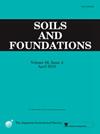高压对含甲烷水合物砂层微生物诱导碳酸钙沉淀的影响
IF 3.3
2区 工程技术
Q2 ENGINEERING, GEOLOGICAL
引用次数: 0
摘要
纽约孢子虫是一种在日本主要岛屿周围海洋中含有甲烷水合物的沉积层中发现的本土微生物。它可以在极冷的温度下生存,并沉淀碳酸钙(CaCO3)。这引起了人们对在微生物诱导碳酸钙沉淀(MICP)中应用微生物的兴趣,以改善周围砂的性质,并促进甲烷水合物的勘探。本研究采用注砂法,在直径为60 cm、高度为70 cm的砂柱上进行了大型室内试验,评价了3.5 MPa和20 MPa高覆盖层压力下,S. newyorkensis的MICP性能。结果表明,在高覆盖层压力下,newyorkensis可使CaCO3沉淀,降低砂体渗透率。无侧限抗压强度和CaCO3的析出量随着距注入井的距离而减小,但在距注入井20 cm处仍保持充足。研究还发现,S. newyorkensis增加了pH值,这将进一步促进CaCO3的沉淀,从而降低水力导电性,稳定含水合物的砂层。本文章由计算机程序翻译,如有差异,请以英文原文为准。
Effects of high pressure on microbiologically induced calcium carbonate precipitation of methane hydrate-bearing sand layers
Sporosarcina newyorkensis is an indigenous microbe found in sedimentary layers bearing methane hydrates in the oceans around Japan’s main islands. It can survive extremely cold temperatures and precipitate calcium carbonate (CaCO3). This has led to interest in applying the microbe in microbiologically induced calcium carbonate precipitation (MICP) to improve the properties of the surrounding sand and to facilitate the exploration of methane hydrates. Using the injection method, a large-scale laboratory experiment was conducted in this study on sand columns with a diameter of 60 cm and a height of 70 cm to evaluate the MICP performance of S. newyorkensis under high overburden pressures of 3.5 and 20 MPa. The results indicated that S. newyorkensis can precipitate CaCO3 at high overburden pressures and reduce the permeability of sand. The unconfined compressive strength and amount of precipitated CaCO3 were seen to decrease with the distance from the injection well, but they remained sufficient to distances of up to 20 cm. S. newyorkensis was also found to increase the pH level, which would further promote CaCO3 precipitation and, in turn, lower hydraulic conductivity and stabilize hydrate-bearing sand formations.
求助全文
通过发布文献求助,成功后即可免费获取论文全文。
去求助
来源期刊

Soils and Foundations
工程技术-地球科学综合
CiteScore
6.40
自引率
8.10%
发文量
99
审稿时长
5 months
期刊介绍:
Soils and Foundations is one of the leading journals in the field of soil mechanics and geotechnical engineering. It is the official journal of the Japanese Geotechnical Society (JGS)., The journal publishes a variety of original research paper, technical reports, technical notes, as well as the state-of-the-art reports upon invitation by the Editor, in the fields of soil and rock mechanics, geotechnical engineering, and environmental geotechnics. Since the publication of Volume 1, No.1 issue in June 1960, Soils and Foundations will celebrate the 60th anniversary in the year of 2020.
Soils and Foundations welcomes theoretical as well as practical work associated with the aforementioned field(s). Case studies that describe the original and interdisciplinary work applicable to geotechnical engineering are particularly encouraged. Discussions to each of the published articles are also welcomed in order to provide an avenue in which opinions of peers may be fed back or exchanged. In providing latest expertise on a specific topic, one issue out of six per year on average was allocated to include selected papers from the International Symposia which were held in Japan as well as overseas.
 求助内容:
求助内容: 应助结果提醒方式:
应助结果提醒方式:


